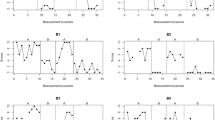Abstract
Conformance proportion is the proportion of a performance characteristic of interest that falls within a prespecified acceptance region, which has been used in various applications. In this article, a simple closed-form interval estimation, based on Student’s t statistic, is proposed for unilateral conformance proportions in balanced and unbalanced random-effects models. Two real datasets are analyzed to illustrate the proposed method, whose performance is also evaluated through detailed simulation studies. The simulation results reveal that the empirical coverage probabilities for upper confidence limits of the method are sufficiently close to the nominal values, but those for lower confidence limits appear to be slightly less than the nominal level. Furthermore, a bootstrap-based calibration for both upper and lower confidence limits is provided to have empirical coverage probabilities closer to the nominal level. This article has supplementary material online.
Similar content being viewed by others
References
Bagui, S. C., Bhaumik, D. K., and Parnes, M. (1996), “One-Sided Tolerance Limits for Unbalanced m-Way Random-Effects ANOVA Models,” Journal of Applied Statistical Science, 3, 135–147.
Burden, R. L., and Faires, J. D. (1985), Numerical Analysis (3rd ed.), Boston: PWS Publishers.
Burdick, R. K., and Graybill, F. A. (1992), Confidence Intervals on Variance Components, New York: Marcel Dekker.
Gaylor, D. W., and Hopper, F. N. (1969), “Estimating the Degrees of Freedom for Linear Combinations of Mean Squares by Satterthwaite’s Formula,” Technometrics, 11, 691–706.
Hannig, J., Iyer, H., and Patterson, P. (2006), “Fiducial Generalized Confidence Intervals,” Journal of the American Statistical Association, 101, 254–269.
Hoffman, D. (2010), “One-Sided Tolerance Limits for Balanced and Unbalanced Random Effects Models,” Technometrics, 52, 303–312.
Hoffman, D., and Kringle, R. (2005), “Two-Sided Tolerance Intervals for Balanced and Unbalanced Random Effects Models,” Journal of Biopharmaceutical Statistics, 15, 283–293.
Hunt, J. W., Anderson, B. S., Phillips, B. M., Newman, J., Tjeerdema, R. S., Fairey, R., Puckett, H. M., Stephenson, M., Smith, R. W., Wilson, C. J., and Taberski, K. M. (2001), “Evaluation and Use of Sediment Toxicity Reference Sites for Statistical Comparisons in Regional Assessments,” Environmental Toxicology and Chemistry, 20, 1266–1275.
Iyer, H. K., and Patterson, P. D. (2002), “A Recipe for Constructing Generalized Pivotal Quantities and Generalized Confidence Intervals,” Technical report 2002/10, Department of Statistics, Colorado State University.
Lai, Y. H., Yen, Y. F., and Chen, L. A. (2012), “Validation of Tolerance Interval,” Journal of Statistical Planning and Inference, 142, 902–907.
LaMotte, L. R., and McWhorter, A. Jr. (1978), “An Exact Test for the Presence of Random Walk Coefficients in a Linear Regression Model,” Journal of the American Statistical Association, 73, 816–820.
Lee, H. I., and Liao, C. T. (2012), “Estimation for Conformance Proportions in a Normal Variance Components Model,” Journal of Quality Technology, 44, 63–79.
Liao, C. T., Lin, T. Y., and Iyer, H. K. (2005), “One- and Two-Sided Tolerance Intervals for General Balanced Mixed Models and Unbalanced One-Way Random Models,” Technometrics, 47, 323–335.
Lidong, E., Hannig, J., and Iyer, H. (2008), “Fiducial Intervals for Variance Components in an Unbalanced Two-Component Normal Mixed Linear Model,” Journal of the American Statistical Association, 103, 854–865.
Perakis, M., and Xekalaki, E. (2002), “A Process Capability Index that Is Based on the Proportion of Conformance,” Journal of Statistical Computation and Simulation, 72, 707–718.
Satterthwaite, F. E. (1946), “An Approximate Distribution of Estimates of Variance Components,” Biometrics Bulletin, 2, 110–114.
Searle, S. R., Casella, G., and McCulloch, C. E. (1992), Variance Components, New York: Wiley.
Smith, R. W. (2002), “The Use of Random-Model Tolerance Intervals in Environmental Monitoring and Regulation,” Journal of Agricultural, Biological, and Environmental Statistics, 7, 74–94.
Smith, J. G., Beauchamp, J. J., and Stewart, A. J. (2005), “Alternative Approach for Establishing Acceptable Thresholds on Macroinvertebrate Community Metrics,” Journal of the North American Benthological Society, 24, 428–440.
Wang, C. M., and Lam, C. T. (1996), “Confidence Limits for Proportion of Conformance,” Journal of Quality Technology, 28, 439–445.
Weaver, B. P., Hamada, M. S., Vardeman, S. B., and Wilson, A. G. (2012), “A Bayesian Approach to the Analysis of Gauge R&R Data,” Quality Engineering, 24, 486–500.
Weerahandi, S. (1993), “Generalized Confidence Intervals,” Journal of the American Statistical Association, 88, 899–905.
Wolfinger, R. D. (1998), “Tolerance Intervals for Variance Component Models Using Bayesian Simulation,” Journal of Quality Technology, 30, 18–32.
Yates, F. (1934), “The Analysis of Multiple Classifications with Unequal Numbers in the Different Classes,” Journal of the American Statistical Association, 29, 51–66.
Author information
Authors and Affiliations
Corresponding author
Electronic Supplementary Material
Rights and permissions
About this article
Cite this article
Lee, HI., Liao, CT. Unilateral Conformance Proportions in Balanced and Unbalanced Normal Random Effects Models. JABES 19, 202–218 (2014). https://doi.org/10.1007/s13253-014-0166-1
Received:
Accepted:
Published:
Issue Date:
DOI: https://doi.org/10.1007/s13253-014-0166-1




